
Click the name of a planet to learn more about its visibility in April 2020. Sole evening planet: Venus. Morning planets: Mars, Jupiter, Saturn, and Mercury.
Try Stellarium for a precise view of the planets from your location.
Want precise planet rise and set times? Click here for recommended almanacs
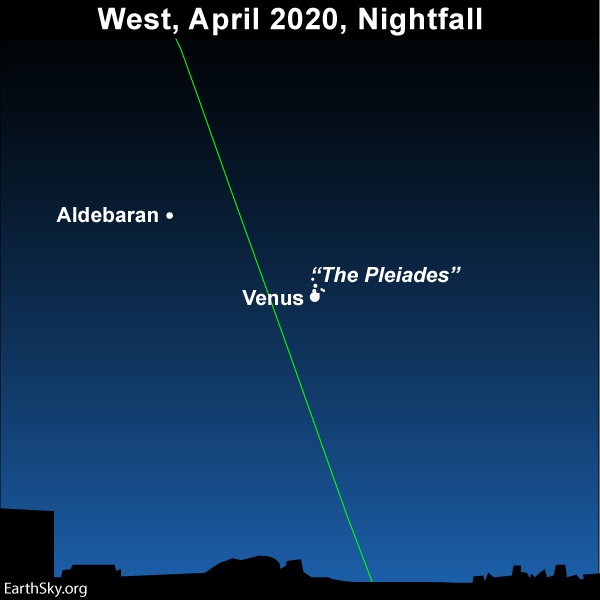
April starts with a bang, as the dazzling planet Venus has a conjunction with the Pleiades. Read more and check out these photos.
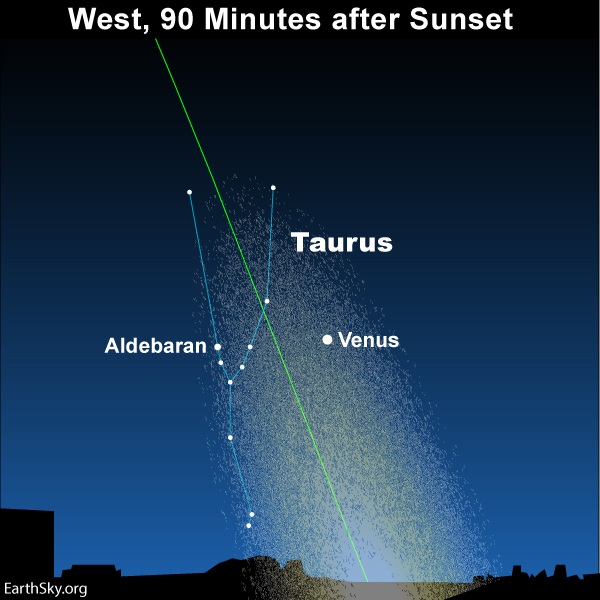
Live in the Northern Hemisphere? Then let the dazzling planet Venus show you where to look for the zodiacal light. Read more.
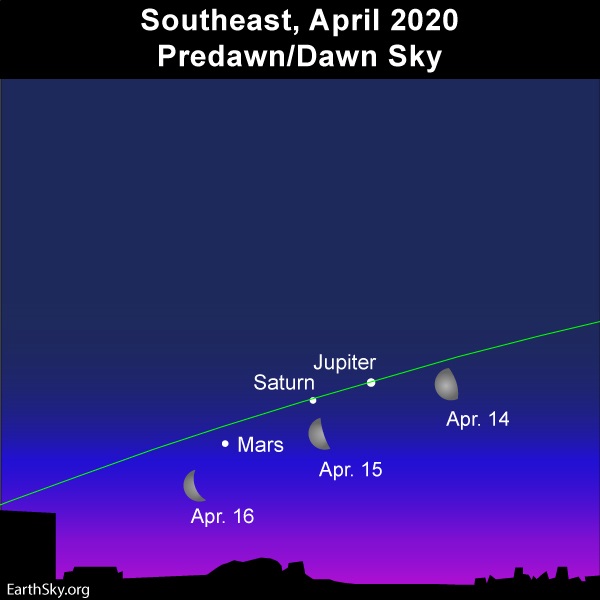
In mid-April 2020, let the waning moon guide your eye to the morning planets: Jupiter, Saturn and Mars. Read more.
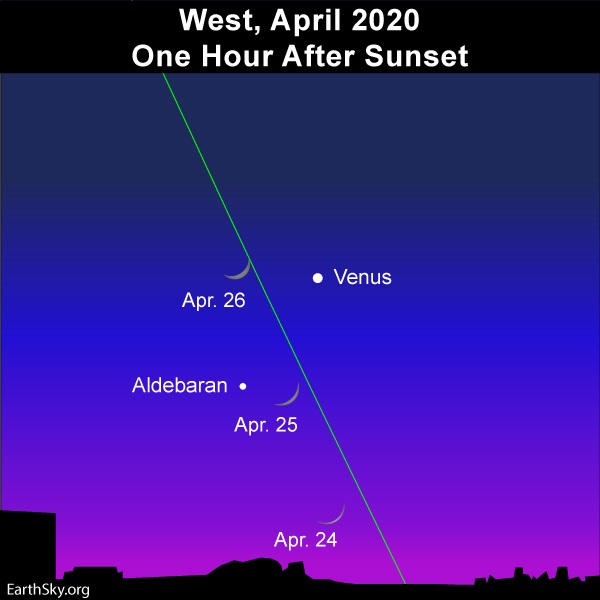
Use Venus to find the young moon, or use the young moon to find Venus, on April 24, 25 and 26, 2020. Read more.
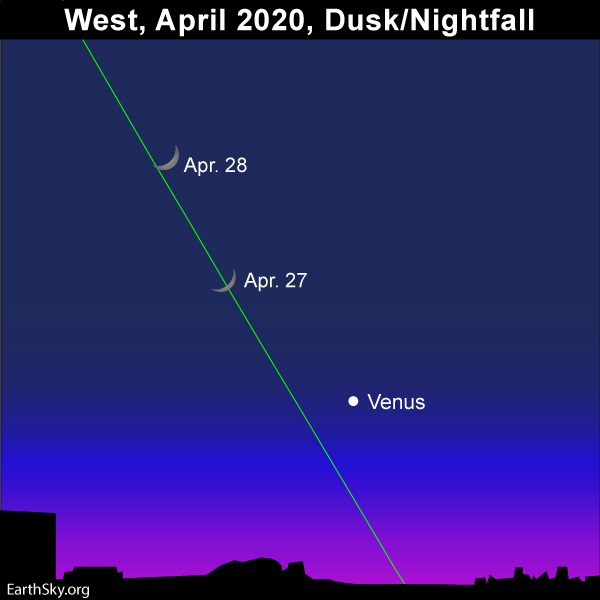
Venus will reach its greatest illuminated extent on April 28, at 1:00 UTC. At U.S. time zones, that’s April 27, at 9 p.m. EDT, 8 p.m. CDT, 7 p.m. MDT and 6 p.m. PDT. Read more.
Venus – the brightest planet – blazes mightily in the western sky after sunset, starting out the month in close conjunction with the Pleiades star cluster. It’s the only bright planet to light up these April evenings all month long. Given clear skies, it’ll be hard to miss Venus, the third-brightest celestial body to light up the heavens, after the sun and moon. Some sharp-sighted people can even see Venus in a daytime sky.
Read more: Venus and Pleiades cluster April 2, 3 and 4, 2020
Venus recently hit a big milestone, reaching its greatest elongation (46 degrees east) from the sun on March 24, 2020. Then, about a week later, Venus reaches another major milestone, as this dazzling world has a conjunction with the Pleiades star cluster in early April 2020. In the Northern Hemisphere, Venus’ dominance doesn’t really subside in April, as this world stays out well after nightfall all month long. Around the world, in both the Northern and Southern Hemispheres, this dazzling world brightens all month long, to shine at its brightest best as the evening “star” in late April and early May 2020.
If you live at mid-to-far northern latitudes, you might be surprised at how high Venus appears at sundown, and also how long this planet stays out after dark. Whenever Venus reaches a greatest evening elongation in close concert with the spring equinox, Venus turns into a virtual night owl for another 5 weeks or so. Although Venus reaches a greatest evening elongation 5 times every 8 years, this favorable convergence of greatest elongation with the spring equinox only happens in cycles of 8 years. Enjoy Venus while the time is at hand!
From a far-northern Arctic outpost, such as Barrow, Alaska (71 degrees north latitude), Venus mimics the midnight sun of summer. From that far north, Venus is actually circumpolar (stays above the horizon for 24 hours a day) all though April 2020.
At mid-northern latitudes, Venus sets about 4 hours after sunset at the beginning of the month, and about 3 1/2 hours after sundown by the month’s end.
At temperate latitudes in the Southern Hemisphere, Venus sets about 2 hours after sunset in early April, and only about 35 to 40 minutes after the sun by the month’s end. In the Southern Hemisphere, Venus’ greatest evening elongation coincided closely with the March autumn equinox, which severely dampens Venus’ evening showing at southerly latitudes.
Around the world, Venus comes closer to Earth day by day, and its shrinking (yet elongating) phase becomes easier and easier to view through the telescope. Venus starts out the month about 47 percent illuminated in sunshine, and finishes the month about 26 percent illuminated. Venus’ angular diameter increases by 150 percent throughout the month, whereas its disk more than doubles in size.
Look for the moon in the vicinity of Venus for several days, centered on or near April 26, 2020.
Mercury puts on a fine morning exhibition for the first few weeks of April in the Southern Hemisphere. That’s because Mercury’s greatest elongation in the morning sky on March 24, 2020, closely coincided with the March autumn equinox, accentuating Mercury’s morning appearance at southerly latitudes.
In the Northern Hemisphere, Mercury’s greatest morning elongation occurred in close concert with the March spring equinox, which submerges Mercury’s appearance in the harsh glow of dawn all through April 2020. From northerly latitudes, you’ll probably need binoculars for any chance of catching Mercury in the morning sky.
Three other morning planets – Mars, Jupiter and Saturn – rise well before dawn all month long, and help you to locate Mercury near the sunrise point on the horizon. Look first for dazzling Jupiter and then draw an imaginary line from Jupiter through Saturn to locate Mercury near the horizon in the predawn/dawn sky.
At temperate latitudes in the Southern Hemisphere, Mercury comes up better than 2 hours before sunrise at the beginning of the month. By mid-April, that tapers to about 1 1/2 hours before sunrise. See the chart below.
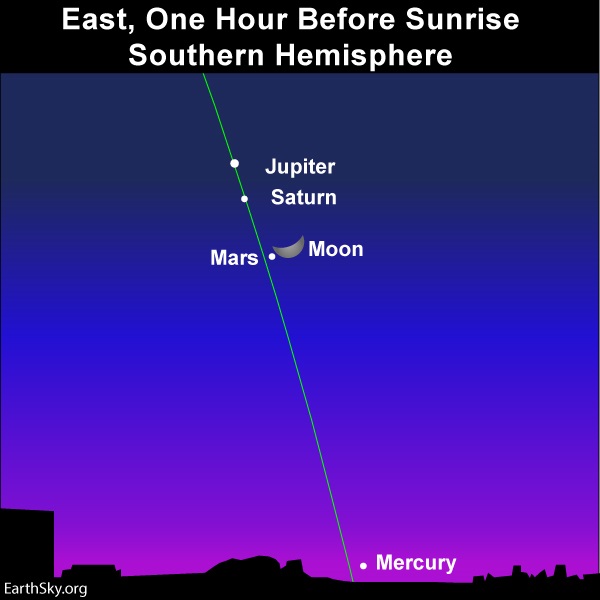
The view of the moon and morning planets from the Southern Hemisphere (Cape Town, South Africa) before sunrise April 16, 2020. Around mid-month at the equator, Mercury rises about one hour before the sun, and at 35 degrees south latitude, Mercury rises about 1 1/2 hours before sunrise. Read more.
Mars swept 0.9 degrees south of Saturn on March 31, 2020. So in April 2020, Jupiter will be the first bright planet to rise in the morning sky, followed by Saturn and then Mars.
At mid-northern latitudes, Mars rises about 3 hours before the sun throughout April. At temperate latitudes in the Southern Hemisphere, Mars comes up an hour or two after midnight in early April, and around midnight by the month’s end.
Let the waning crescent moon help guide your eye to Mars for several mornings, centered on or near April 16.
Mars was in conjunction with the sun – or almost behind the sun as seen from Earth – on September 2, 2019. It was far across the solar system from us at the time. But Earth is now moving toward the red planet, reducing the distance between us and Mars each month. Even so, it’ll be a number of months before we catch Mars, the swiftest-moving superior planet. And so it is, always, for Mars, which alternates years appearing bright in our sky, or faint. 2019 was a dull year, but 2020 will be an exciting one, for Mars!
The excitement will build slowly, though. In April 2020 … you’ll still find Mars only modestly-bight before dawn. We’ll be rushing along in our smaller, faster orbit, trying to catch up with Mars. As northern summer 2020 approaches, Mars will begin to change. It’ll brighten more dramatically as, finally, Earth begins to close in on Mars. The red planet will appear brightest in our sky and fiery red – around the time of its opposition – when Earth passes between Mars and the sun on October 13, 2020.
Jupiter – the second-brightest planet – is a morning planet all month long. At mid-northern latitudes, Jupiter rises about 3 1/2 hours before the sun in early April, and about 4 1/2 hours before the sun by the month’s end. At temperate latitudes in the Southern Hemisphere, Jupiter rises around midnight in early April, and late evening by the month’s end.
Before sunrise on or near April 14, let last quarter help guide you to Jupiter (and nearby Saturn and Mars!).
Watch for Jupiter to gain prominence in the morning sky throughout April 2020.
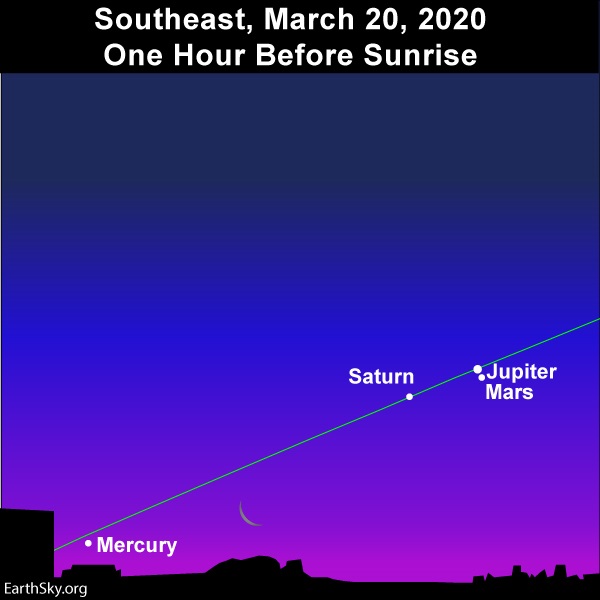
In 2020, the planets Mars and Jupiter will be in conjunction at the March 20 equinox.
Saturn is the second of a string of three bright morning planets – Jupiter, Saturn and Mars – to rise into the morning sky. Saturn rises before dawn for most of the world (except far-northern latitudes). Look first for brilliant Jupiter and you’ll find Saturn a short hop to the east of Jupiter. Remember, east is in the direction of sunrise.
From mid-northern latitudes, Saturn rises about 3 hours before the sun at the beginning of the month, and about an hour after midnight by the month’s end. (By midnight, we mean midway between sunset and sunrise.) From temperate latitudes in the Southern Hemisphere, Saturn rises shortly after midnight in early April, and late evening by the month’s end.
Watch for the waning crescent moon to swing close to Saturn on or near April 15.
What do we mean by bright planet? By bright planet, we mean any solar system planet that is easily visible without an optical aid and that has been watched by our ancestors since time immemorial. In their outward order from the sun, the five bright planets are Mercury, Venus, Mars, Jupiter and Saturn. These planets actually do appear bright in our sky. They are typically as bright as – or brighter than – the brightest stars. Plus, these relatively nearby worlds tend to shine with a steadier light than the distant, twinkling stars. You can spot them, and come to know them as faithful friends, if you try.
Bottom line: In April 2020, Venus lights up the west after sunset. In the predawn/dawn sky, note the short string of planets: Very bright Jupiter at top, Saturn in the middle, and Mars at bottom.
Don’t miss anything. Subscribe to EarthSky News by email
Visit EarthSky’s Best Places to Stargaze, and recommend a place we can all enjoy.
Help EarthSky keep going! Donate now.
Post your planet photos at EarthSky Community Photos
from EarthSky https://ift.tt/1YD00CF

Click the name of a planet to learn more about its visibility in April 2020. Sole evening planet: Venus. Morning planets: Mars, Jupiter, Saturn, and Mercury.
Try Stellarium for a precise view of the planets from your location.
Want precise planet rise and set times? Click here for recommended almanacs

April starts with a bang, as the dazzling planet Venus has a conjunction with the Pleiades. Read more and check out these photos.

Live in the Northern Hemisphere? Then let the dazzling planet Venus show you where to look for the zodiacal light. Read more.

In mid-April 2020, let the waning moon guide your eye to the morning planets: Jupiter, Saturn and Mars. Read more.

Use Venus to find the young moon, or use the young moon to find Venus, on April 24, 25 and 26, 2020. Read more.

Venus will reach its greatest illuminated extent on April 28, at 1:00 UTC. At U.S. time zones, that’s April 27, at 9 p.m. EDT, 8 p.m. CDT, 7 p.m. MDT and 6 p.m. PDT. Read more.
Venus – the brightest planet – blazes mightily in the western sky after sunset, starting out the month in close conjunction with the Pleiades star cluster. It’s the only bright planet to light up these April evenings all month long. Given clear skies, it’ll be hard to miss Venus, the third-brightest celestial body to light up the heavens, after the sun and moon. Some sharp-sighted people can even see Venus in a daytime sky.
Read more: Venus and Pleiades cluster April 2, 3 and 4, 2020
Venus recently hit a big milestone, reaching its greatest elongation (46 degrees east) from the sun on March 24, 2020. Then, about a week later, Venus reaches another major milestone, as this dazzling world has a conjunction with the Pleiades star cluster in early April 2020. In the Northern Hemisphere, Venus’ dominance doesn’t really subside in April, as this world stays out well after nightfall all month long. Around the world, in both the Northern and Southern Hemispheres, this dazzling world brightens all month long, to shine at its brightest best as the evening “star” in late April and early May 2020.
If you live at mid-to-far northern latitudes, you might be surprised at how high Venus appears at sundown, and also how long this planet stays out after dark. Whenever Venus reaches a greatest evening elongation in close concert with the spring equinox, Venus turns into a virtual night owl for another 5 weeks or so. Although Venus reaches a greatest evening elongation 5 times every 8 years, this favorable convergence of greatest elongation with the spring equinox only happens in cycles of 8 years. Enjoy Venus while the time is at hand!
From a far-northern Arctic outpost, such as Barrow, Alaska (71 degrees north latitude), Venus mimics the midnight sun of summer. From that far north, Venus is actually circumpolar (stays above the horizon for 24 hours a day) all though April 2020.
At mid-northern latitudes, Venus sets about 4 hours after sunset at the beginning of the month, and about 3 1/2 hours after sundown by the month’s end.
At temperate latitudes in the Southern Hemisphere, Venus sets about 2 hours after sunset in early April, and only about 35 to 40 minutes after the sun by the month’s end. In the Southern Hemisphere, Venus’ greatest evening elongation coincided closely with the March autumn equinox, which severely dampens Venus’ evening showing at southerly latitudes.
Around the world, Venus comes closer to Earth day by day, and its shrinking (yet elongating) phase becomes easier and easier to view through the telescope. Venus starts out the month about 47 percent illuminated in sunshine, and finishes the month about 26 percent illuminated. Venus’ angular diameter increases by 150 percent throughout the month, whereas its disk more than doubles in size.
Look for the moon in the vicinity of Venus for several days, centered on or near April 26, 2020.
Mercury puts on a fine morning exhibition for the first few weeks of April in the Southern Hemisphere. That’s because Mercury’s greatest elongation in the morning sky on March 24, 2020, closely coincided with the March autumn equinox, accentuating Mercury’s morning appearance at southerly latitudes.
In the Northern Hemisphere, Mercury’s greatest morning elongation occurred in close concert with the March spring equinox, which submerges Mercury’s appearance in the harsh glow of dawn all through April 2020. From northerly latitudes, you’ll probably need binoculars for any chance of catching Mercury in the morning sky.
Three other morning planets – Mars, Jupiter and Saturn – rise well before dawn all month long, and help you to locate Mercury near the sunrise point on the horizon. Look first for dazzling Jupiter and then draw an imaginary line from Jupiter through Saturn to locate Mercury near the horizon in the predawn/dawn sky.
At temperate latitudes in the Southern Hemisphere, Mercury comes up better than 2 hours before sunrise at the beginning of the month. By mid-April, that tapers to about 1 1/2 hours before sunrise. See the chart below.

The view of the moon and morning planets from the Southern Hemisphere (Cape Town, South Africa) before sunrise April 16, 2020. Around mid-month at the equator, Mercury rises about one hour before the sun, and at 35 degrees south latitude, Mercury rises about 1 1/2 hours before sunrise. Read more.
Mars swept 0.9 degrees south of Saturn on March 31, 2020. So in April 2020, Jupiter will be the first bright planet to rise in the morning sky, followed by Saturn and then Mars.
At mid-northern latitudes, Mars rises about 3 hours before the sun throughout April. At temperate latitudes in the Southern Hemisphere, Mars comes up an hour or two after midnight in early April, and around midnight by the month’s end.
Let the waning crescent moon help guide your eye to Mars for several mornings, centered on or near April 16.
Mars was in conjunction with the sun – or almost behind the sun as seen from Earth – on September 2, 2019. It was far across the solar system from us at the time. But Earth is now moving toward the red planet, reducing the distance between us and Mars each month. Even so, it’ll be a number of months before we catch Mars, the swiftest-moving superior planet. And so it is, always, for Mars, which alternates years appearing bright in our sky, or faint. 2019 was a dull year, but 2020 will be an exciting one, for Mars!
The excitement will build slowly, though. In April 2020 … you’ll still find Mars only modestly-bight before dawn. We’ll be rushing along in our smaller, faster orbit, trying to catch up with Mars. As northern summer 2020 approaches, Mars will begin to change. It’ll brighten more dramatically as, finally, Earth begins to close in on Mars. The red planet will appear brightest in our sky and fiery red – around the time of its opposition – when Earth passes between Mars and the sun on October 13, 2020.
Jupiter – the second-brightest planet – is a morning planet all month long. At mid-northern latitudes, Jupiter rises about 3 1/2 hours before the sun in early April, and about 4 1/2 hours before the sun by the month’s end. At temperate latitudes in the Southern Hemisphere, Jupiter rises around midnight in early April, and late evening by the month’s end.
Before sunrise on or near April 14, let last quarter help guide you to Jupiter (and nearby Saturn and Mars!).
Watch for Jupiter to gain prominence in the morning sky throughout April 2020.

In 2020, the planets Mars and Jupiter will be in conjunction at the March 20 equinox.
Saturn is the second of a string of three bright morning planets – Jupiter, Saturn and Mars – to rise into the morning sky. Saturn rises before dawn for most of the world (except far-northern latitudes). Look first for brilliant Jupiter and you’ll find Saturn a short hop to the east of Jupiter. Remember, east is in the direction of sunrise.
From mid-northern latitudes, Saturn rises about 3 hours before the sun at the beginning of the month, and about an hour after midnight by the month’s end. (By midnight, we mean midway between sunset and sunrise.) From temperate latitudes in the Southern Hemisphere, Saturn rises shortly after midnight in early April, and late evening by the month’s end.
Watch for the waning crescent moon to swing close to Saturn on or near April 15.
What do we mean by bright planet? By bright planet, we mean any solar system planet that is easily visible without an optical aid and that has been watched by our ancestors since time immemorial. In their outward order from the sun, the five bright planets are Mercury, Venus, Mars, Jupiter and Saturn. These planets actually do appear bright in our sky. They are typically as bright as – or brighter than – the brightest stars. Plus, these relatively nearby worlds tend to shine with a steadier light than the distant, twinkling stars. You can spot them, and come to know them as faithful friends, if you try.
Bottom line: In April 2020, Venus lights up the west after sunset. In the predawn/dawn sky, note the short string of planets: Very bright Jupiter at top, Saturn in the middle, and Mars at bottom.
Don’t miss anything. Subscribe to EarthSky News by email
Visit EarthSky’s Best Places to Stargaze, and recommend a place we can all enjoy.
Help EarthSky keep going! Donate now.
Post your planet photos at EarthSky Community Photos
from EarthSky https://ift.tt/1YD00CF


Aucun commentaire:
Enregistrer un commentaire